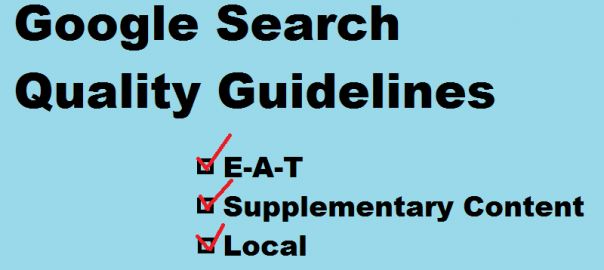Remember when Google updated their search quality guidelines back in November? Here’s hoping you didn’t commit everything to memory.
Google has updated their search quality rating guidelines again. Many of the changes reflect the user-centric direction Google has been going in all year long. From a greater emphasis on E-A-T to some surprising mobile changes, the update is another gift from Google, showing us what they want from our websites.
Here are the key takeaways from the Google search quality rater update, complied in yet another great post from The SEM Post. You should absolutely implement these to bolster your SEO efforts.
E-A-T, Your Money Your Life
The Google search quality rater update added a brand new section on the “most important factors” for overall Page Quality rating:
Main Content Quality and Amount: The rating should be based on the landing page of the task URL.
Website Information/information about who is responsible for the website: Links to help with website information research will be provided.
Website Reputation: Links to help with reputation research will be provided.
Expertise, Authoritativeness, Trustworthiness: This is an important quality characteristic. Use your research on the areas above to inform your rating.
The next section goes a bit more into what goes into the E-A-T of a website: “The amount of expertise, authoritativeness, and trustworthiness (E-A-T) that a webpage/website has is very important. MC quality and amount, website information, and website reputation all inform the E-A-T of a website.”
What the changes to E-A-T and YMYL means for you:
We wrote about the importance of E-A-T recently. Both E-A-T and YMYL (Your Money Your Life) help tell Google how highly they should value your site. What’s helpful is that the update to the search quality rating guidelines specifies what parts of your content goes into E-A-T (see the first three bullets). This should help you create the most expert, authoritative, and trustworthy content possible for your site.
Moving forward, you still need to spend a lot of time on your content. The concept of E-A-T and the search quality guidelines are so closely tied, you can’t ignore its importance. Remember, E-A-T is a ranking factor. So put in the work, and you’ll reap the benefits.
Supplementary Content
Several mentions of Supplementary Content were removed with the search quality rating guidelines update. Supplementary content includes content that “contributes to a good user experience on the page, but does not directly help the page achieve its purpose.” Removing the mentions places a de-emphasis on supplementary content, but doesn’t outright condemn it.
Google recommends their search raters “use their judgment” on a number of factors, including whether a page’s Supplementary Content is helping or hurting user experience.

What the changes to Supplementary Content means for you:
Google has been known to go back on things when they aren’t working. The removal of supplementary content shows that the high emphasis they had placed before on it wasn’t producing ideal results. Given the current search climate, this removal is because supplementary content isn’t always helpful on mobile. Suggestions for other products, plugins showing related content on other sites, and the like can get in the way of a page’s main content. To ensure the best user experience, you should really think about whether those sections are to the user’s advantage.
Most mentions of Supplementary Content that are still in the guidelines are left in the Low Quality Pages sections. Not that having Supplementary Content means your pages will be Low Quality—rather, this shows Google’s intentions with the move, that supplementary content can have an adverse user experience for someone looking up a site on mobile.
The search quality rating guidelines are what Google’s quality raters adhere to when developing Google’s algorithms. So when Google says to “use your judgment,” they’re telling their raters to look at how supplementary content is used and whether it offers users an adverse experience.
That said, you don’t want to remove your supplementary content, even “just in case.” But you should look at it on a case-by-case basis and make sure if it’s really helping.
Visit-in-Person Rating Queries (Local)
All instances of the term “Local” has been changed to “visit-in-person.” In the relevant sections, raters are advised to consider the possibility of visit-in-person when determining a search query, this due in large part to the prevalence of mobile phones.
What the changes to Local Rating name means for you:
The name change is probably to accommodate international search raters who might be confused by the term “local.” It will likely have little impact with how webmasters make their websites. Maybe “visit-in-person” will replace “local” as part of the everyday SEO vernacular too, but we’ll just have to wait and see.
Other Changes to the Search Quality Rating Guidelines
With the search quality rater document going from 160 pages down to 146, there are several guidelines that have gotten removed. We won’t go into them in as much detail as the above (which are incredibly important), but they are still worth mentioning:
- Functional Page Design – The guidelines on placing main content “front and center” as well as being “immediately visible when a user opens a page” has been removed.
- Paywalls – Google wants search raters to take note of sites that are blocked by paywalls, even with the customary ad block-free environments raters are supposed to use.
- Non-determinate Page Rating – Contrary to popular belief, Page Quality score is not determined by the “type” of page. As long as the content is useful, even a Wikipedia article can rank.
- Tabbed Content – Content in tabs, such as customer reviews, can be considered part of the Main Content now.
- Ads – “Ads may contribute to a good user experience.” That’s lifted straight from the new search rater guidelines, and it probably refers to related ads that lead to a good customer experience.
These are just a few of the notable changes. Here’s the document if you want to see all the changes for yourself.
E-A-T More; Take Fewer Supplements
We can’t stress enough how important it is for you to “E-A-T right.” If you’re stumped on what kind of content shows your site’s expertise, authoritativeness, and trustworthiness, that’s something you need to know. Likewise, you also have to be a good judge for what Supplemental Content is working for your site.
Digital & Social Articles on Business 2 Community(87)








